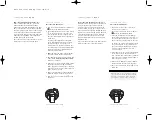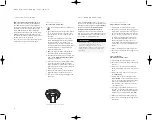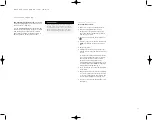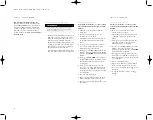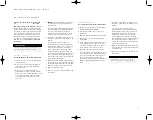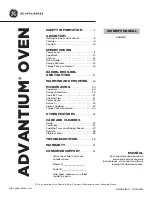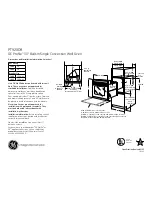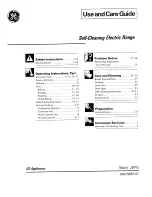
6
D U A L - S T A C K E D B U R N E R
A S S E M B L Y
The unique dual-stacked burner design
combines all of the burner parts in one
assembly.
After cleaning or removing burner parts for
any reason, it is extremely important that you
reassemble burners correctly.
The burner cap must be seated flatly on the
burner. There is a groove on the bottom of the
burner cap. Adjust the burner cap until it drops
into place and is seated flat on top of the
burner. Failure to do this will result in a poor
flame. Refer to the illustration below.
S U R FA C E
B U R N E R S
A spark electrode ignites each surface burner.
This control eliminates the need for continuous
open flame pilots. For added safety and
convenience, each burner is designed with an
electronic reignition system. This feature
enables any burner to relight automatically in
the event it is accidentally extinguished.
Large burners provide a rating of 3.9 kW
(14.0 MJ) on
with 0.37 kW (1.36 MJ) deliv-
ered at simmer. The small burner provides a
rating of 2.5 kW (9.0 MJ) on
with 0.23 kW
(0.82 MJ) delivered at simmer. All burners
have simmer settings.
A distinguishing feature of Wolf’s low kW
control is its constant, low heat output without
continuous ignitions. The flame diameter
remains full size; only the heat output is
lowered. This patented dual-stacked burner
design makes it possible to enjoy cooking at
full flame as well as maintain control while
simmering at the lowest flame setting.
W O L F D U A L F U E L R A N G E
S U R FA C E O P E R AT I O N
Burner Cap
Igniter
Sealed Burner
Dual-stacked burner assembly.
Nyliner Insertion
Nyliner insertion.
Failure to position the burner parts
correctly could cause flames or gas to
escape, causing heat damage to your
range, or burn between parts, resulting
in poor combustion.
C O N T R O L
K N O B S
The control knobs are positioned to corre-
spond to the burners they regulate. The knobs
on the far left regulate the burners on the left
side. Conversely, the knobs on the far right
regulate the burners on the right side.
The precision fit of the control knobs requires
the use of a nyliner insertion between the knob
and bezel. When removing knobs for cleaning,
place the bearing back inside the bezel for easy
reinstallation of the knobs. Refer to the illustra-
tion below.
C O O K T O P
O P E R AT I O N
The cooktop burner uses an electronic igniter
in place of a standing pilot. When the cooktop
control knob is pushed in and turned to the
position, the system creates a spark to
light the burner. This sparking continues for 4
seconds or until the electronic ignition senses a
flame, which ever comes first. If the igniter fails
to ignite the gas in 4 seconds, the gas safety
shutoff valve will close, eliminating the gas
flow for 5 seconds. The valve will reopen after
the purge time of 5 seconds, and the igniter
will automatically attempt to re-ignite the gas.
This cycle of events is attempted 3 times. After
the third attempt, in order for gas to flow to the
burner once again, the user must return the
knob to the
position and then turn the
knob to the
position.
To check operation of the cooktop burner, push
in and turn the control knob to the
position. The flame should light within four
seconds.
If the burner does not light properly, turn the
control knob to the
position. Check that
the burner head is in the proper position.
Check that the power supply cord is plugged in
and that the circuit breaker or house fuse has
not blown.
Check operation again; If flame is not estab-
lished within the ignition cycle time, release
the knob, open a door and wait 1 minute
before attempting a new ignition procedure.
If the flames are extinguished - for any reason
whatever - turn OFF the control knob and wait
at least 1 minute before retrying to ignite the
burner.
Ensure that the flames do not extinguish when
you reduce to low flame quickly. Check correct
operation of each burner individually and in
combination.
Never leave pans on a
setting unat-
tended. Be particularly cautious when
cooking food in fat or grease. It can
become hot enough to ignite.

















